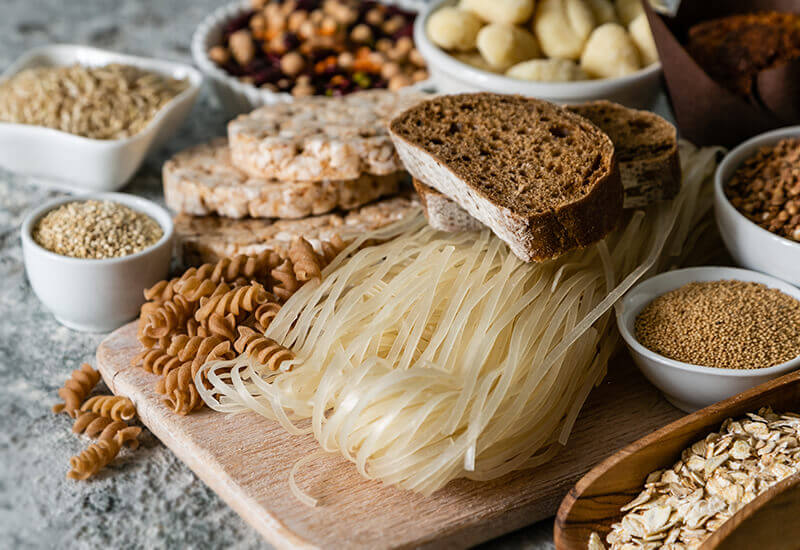Description
Physical activity is essential for a healthy body and mind. Cardiovascular exercises are aerobic exercises that elevate the heart rate for an extended period and help to improve heart and lung function. Skeletal muscle conditioning exercises increase muscle strength and improve bone health. A combination of these exercise types help individuals to maintain a healthy lifestyle.
However, everyone responds differently to particular exercises, whether the goal is to lose weight, improve muscle tone or run a faster marathon. For example, some overweight individuals will lose significant weight by starting a walking or running program. Others won’t lose any weight with this method, but may see great benefits from strength training at the gym. An individual’s upbringing, current lifestyle and genetic variation all contribute to these differences.
Athletic ability is also heavily influenced by genetic variation. Recent studies have identified multiple genetic variants that are more prevalent in endurance athletes, while different genetic variants frequently occur in sprinters and other power athletes. Genetic variation also influences an individual’s exercise motivation, exercise tolerance, susceptibility to injury and pain tolerance. An understanding of your genetics is very beneficial to allow for a personalized exercise program to achieve specific sport and health goals. The genetic variants identified in this panel have been studied in Caucasian populations, but the same association may not be apparent in other ethnicities.
TURNAROUND TIME
SAMPLE TYPE
AGE REQUIREMENT
GENDER
Test Details
Muscle fibres
Our skeletal muscle is composed of bundles of muscle fibres known as myocytes. Myocytes contain myofibril strands that generate muscle contractions by shortening the skeletal muscle. Muscle fibres exist as two main types – slow-twitch and fast-twitch.
Slow-twitch muscle fibres are beneficial for endurance sports, as these muscle fibres are more efficient at using oxygen to generate fuel, and they can continue to work for an extended period before tiring. Endurance sports include mountain climbing and long-distance running, swimming and cycling.
Fast-twitch muscle fibres are beneficial for power sports, as these muscle fibres fire very quickly and are needed for sudden bursts of energy. However, they fatigue a lot more quickly than slow-twitch muscle fibres. Power sports are athletic events that require a high power, strength and/or speed ability, including weight lifting, sprinting and jumping events.
Although we each have a mix of slow-twitch and fast-twitch muscle fibres, world-class endurance athletes generally have a much higher proportion of slow-twitch fibres, while international power athletes have a higher proportion of fast-twitch fibres. Genetic variation, along with athletic training, influences an individual’s proportion of slow- and fast-twtich muscle fibres.
Athletic power ability - the AGT, IL6 and ACTN3 genes
Power sports are sports and athletic events that require a high power, strength and/or speed ability. Power ability is influenced by gender, age, level of physical activity and several genetic variations.
- The AGT gene encodes the angiotensinogen hormone, which is important for blood pressure regulation, cardiovascular homeostasis, and skeletal and muscle growth. A common genetic variation in the AGT gene affects the levels of the angiotensinogen hormone and influences athletic power ability.
- Interleukin-6 (IL6) is an important messenger molecule for bone and muscle growth and for controlling the inflammatory response to infection and injury. A common genetic variant in the IL6 gene has been linked to increased muscle mass and is more common in Caucasian males athletes that excel at power sports, particularly weight lifting. The affect of this variant is unknown in Caucasian females or other ethnicities. In Caucasian populations, the increased muscle variant is the less common (minor) allele, but it is the more common (major) allele in other ethnicities (e.g. at, or near to, 100% in Han Chinese and Japanese). Hence, it is unlikely to be associated with athletic power ability in other ethnicities.
- The ACTN3 gene is known as the “speed gene” or the “sprinter gene”, due to its link to high sports performance. ACTN3 encodes the alpha-actinin-3 protein found in the fast-twitch muscle fibres. A common genetic variation in the ACTN3 gene prevents the production of a full-length functional protein. Individuals with this change do not produce as many fast-twitch muscle fibres and are less likely to excel at high intensity activities, whereas the fully functional ACTN3 gene is very common in world-class sprinters. Not surprisingly, the functional form of the ACTN3 gene is present in a much higher proportion of people of west African descent, contributing to their sprinting advantage on the world stage.
Athletic endurance gbility – the ACE, ADRB2, GSTP1, PPARA, PPARD and VEGFA genes
Athletic endurance refers to the ability to continue exercising for an extended period. Endurance athletes often have a higher maximal oxygen consumption compared to power athletes. Endurance ability is influenced by gender, age, level of physical activity and several genetic variations.
- The ACE gene encodes the angiotensin-converting enzyme (Ace), which regulates blood pressure and maintains the correct balance of fluids and salts. A common genetic variation in the ACE gene is known as an insertion/deletion polymorphism. The insertion variant contains an extra 287 nucleotides, and results in lower Ace levels, compared to the deletion variant. The insertion variant is associated with increased muscle efficiency (in Caucasians), which is necessary for endurance events. The insertion variant has been identified in many Caucasian endurance athletes, ironman athletes, mountaineers and rowers. Interestingly, the East African nations of Kenya and Ethiopia that dominate long-distance running, do not show the same association between the insertion ACE allele and endurance ability. Asian populations also do not show an association between the insertion allele and endurance ability. Although the deletion variant has a negative impact on endurance ability, it has been linked to increased athletic power ability.
- The ADRB2 gene encodes the beta-2 adrenergic receptor. This receptor interacts with epinephrine to control smooth muscle relaxation, and is also involved in energy balance regulation. A common genetic variant in the ADRB2 gene is associated with increased endurance ability.
- The PPARA gene encodes a peroxisome proliferator-activated receptor that is important for the activation of other genes involved in energy metabolism, body weight regulation and vascular formation. This receptor is expressed at higher levels in slow-twitch (endurance) muscle fibres compared to fast-twitch (power/sprinter) muscle fibres. A genetic variation in the PPARA gene influences the proportions of slow-twitch and fast-twitch muscle fibres and affects endurance and power/strength abilities.
- The PPARD gene encodes a peroxisome proliferator-activated receptor that is important for the activation of other genes in response to fatty acid derivatives. A genetic variation in the PPARD gene is one of many variants that affect endurance ability in Caucasian populations. However, this variant does not affect endurance ability in African Americans or Koreans, and the affect is unknown for other ethnicities.
- The VEGFA gene encodes the vascular endothelial growth factor alpha. This is a signaling protein, which stimulates the production of new blood vessels and helps maintain and restore the oxygen supply to tissues. A genetic variant in the VEGFA gene affects endurance ability in Caucasians and African Americans.
Endurance training health benefits – the PPARGC1A gene
Aerobic capacity refers to the length of time that an individual can maintain aerobic activity. Aerobic activity is physical activity that depends primarily on the use of oxygen to meet energy demands. Aerobic activity occurs in longer distance endurance events (e.g. running or cycling), as it is more economical and can last for an extended period (compared to anaerobic activity). Aerobic capacity can be improved by both endurance (aerobic) training and short, higher intensity anaerobic workouts.
- The PPARGC1A gene encodes a peroxisome proliferator-activated receptor that is important for the activation of other genes involved in metabolism and muscle fibre formation. A genetic variant in the PPARGC1A gene affects aerobic capacity improvements after endurance training in Caucasian populations.
Lactate Transport - the MCT1 gene
During anaerobic exercise, the muscles do not receive enough oxygen for the normal conversion of pyruvate to acetyl CoA, (which then enters the Krebs cycle to generate energy). Instead pyruvate is converted to lactate and this is transported into the muscle cells as an alternative energy source. Lactate is commonly, but incorrectly, referred to as lactic acid and blamed for muscle pain during and after exercise. Recent research has dispelled this myth and actually illustrates the benefits of lactate production, such as the increase in mitochondria within our muscle cells in response to lactate formation. Mitochondria are the energy powerhouses of our cells. A common variant in the MCT1 gene has been associated with reduced transport and utilization of lactate, resulting in reduced athletic ability (in Caucasian males).
- The MCT1 gene encodes the monocarboxylase transporter, which is required to transport lactate across the muscle cell membrane. A genetic variant in the MCT1 gene reduces the lactate transport into the muscle cells. Caucasian males with this variant have a reduced ability to use lactate as an energy source. Preliminary studies have linked this variant with a reduced ability at high-intensity exercise (e.g. circuit training), as well as reduced athletic endurance ability.
Exercise motivation & tolerance - the BDNF and CRP genes
Adequate physical activity is essential for a healthy body and mind. However, many people lack the motivation for physical exercise or have a low exercise tolerance, increasing their risk of obesity and other health problems.
- The BDNF gene encodes a neurotrophin, which has an important role in energy balance regulation in the brain. A genetic variation in the BDNF gene is one genetic factor that influences the motivation to exercise. Individuals with the increased motivation allele experience lower perceived exertion and a lower heart rate, resulting in an increased positive mood while exercising.
- The CRP gene encodes the C-reactive protein, which is involved in the inflammatory response. Lower CRP levels are associated with increased exercise tolerance and an increased heart rate recovery (i.e. it takes a shorter time for heart rate to return to normal after exercise). A genetic variant in the CRP gene affects an individual’s baseline CRP levels and influences their exercise tolerance.
Injury risk - the COL1A1 and COL5A1 genes
Collagen is the main structural component of our connective tissues. It can be rigid (e.g. bones), compliant (e.g. ligaments and tendons) or a combination of rigid and compliant (e.g. cartilage).
- The COL1A1 gene encodes the major component of type I collagen, which is found in most connective tissues. A genetic variant in the COL1A1 gene alters the collagen formation and reduces the risk of soft tissue injury.
- The COL5A1 gene encodes a component of fibrillar collagen type 5. A common variation in the COL5A1 gene affects flexibility, the risk of tendon injury and endurance running ability. One variant has specifically been linked to increased risk of Achilles tendinopathy. Achilles tendinopathy is a painful condition characterized by swelling and stiffness of the Achilles tendon, likely due to ongoing damage. Achilles tendinopathy differs from an acute Achilles rupture, which does not appear to be associated with this COL5A1 variant.
Pain tolerance - the COMT gene
Pain tolerance refers to the maximum level of pain that an individual can withstand before the pain significantly affects them. Pain tolerance varies considerably between individuals and can be affected by several factors. Depression, anxiety, sedentary lifestyle, smoking, obesity and chronic disease are all linked to decreased pain tolerance.
- The COMT gene encodes the catechol-O-methyltransferase enzyme, which is responsible for breaking down neurotransmitters in the brain (e.g. dopamine, epinephrine and norepinephrine). A common genetic variation in the COMT gene affects an individual’s tolerance to chronic pain, and affects the required morphine dose to achieve pain relief. Interestingly, individuals with the higher pain tolerance variant can withstand a higher level of chronic pain, but will require a higher level of morphine if pain relief is required.





